Year: 1994
Directed by: Hiroyuki Ochi
Written by: Akinori Endo, Chiaki Konaka
IMDB Reference
Degree of Cyberpunk Visuals: High
Correlation to Cyberpunk Themes: Very High
Key Cast Members:
Armitage: Hiroko Kasahara
Ross Sylibus: Yasunori Masutani
D’Anclaude: Ryûsei Nakao
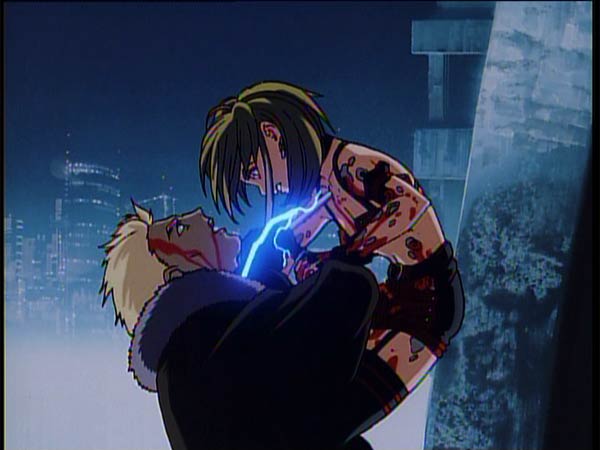
Overview: Armitage III, one of the many Chiaka Konaka written masterpieces (along with Serial Experiments Lain, Texhnolyze, Malice@Doll) is simply an awesome story. If you like Blade Runner and haven’t seen Armitage, you’re doing yourself a disservice. Most of the same issues are raised there, but are done in an original enough way that makes you absolutely love this little anime chick. Humanity as an exclusionary concept which also implies “worth” is fully explored here. Are androids still supposed to just be our servants even if they do have a sense of self-worth?
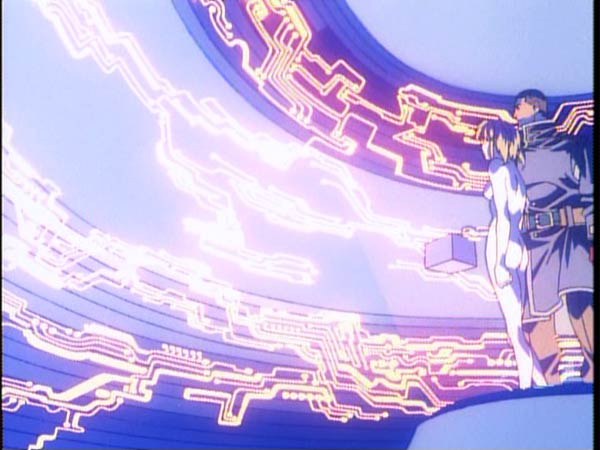
Set in a Blade Runner-like future, mostly centering on Mars, Naomi Armitage is a type III series android who works as a cop on Mars, along with her new partner, Ross Sylibus. While most of the public knows about, and barely tolerates the type II series, they are not aware that there are a few lifelike, human-acting type III series androids living among them. Unfortunately for the robots though, someone knows of their existence and is systematically killing them one by one.
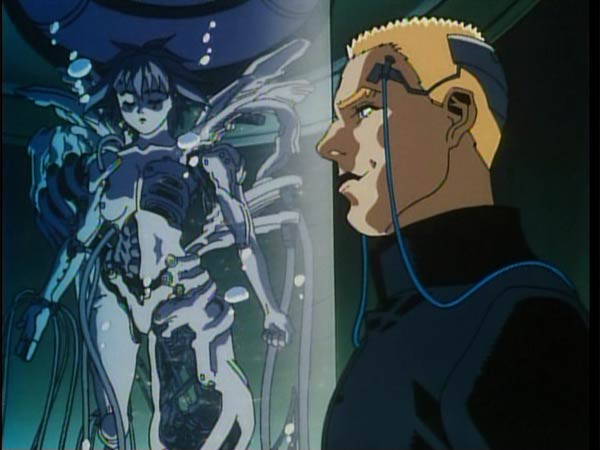
As the plot progresses, Ross, who doesn’t like robots (his former partner was killed by a cyborg) learns that Armitage is an android. Even worse, they learn that the murderer is a series IV robot. Armitage, who starts off as a wise-cracking, disrespectful cop who dresses in sleazy clothes starts to question her “humanity” such as it is. In addition to realizing she’s one of the very few left, Armitage wonders why she was ever created. As she struggles to maintain “sanity,” Ross begin to develop a closer relationship - one that is not too mushy, and works well with the pacing.
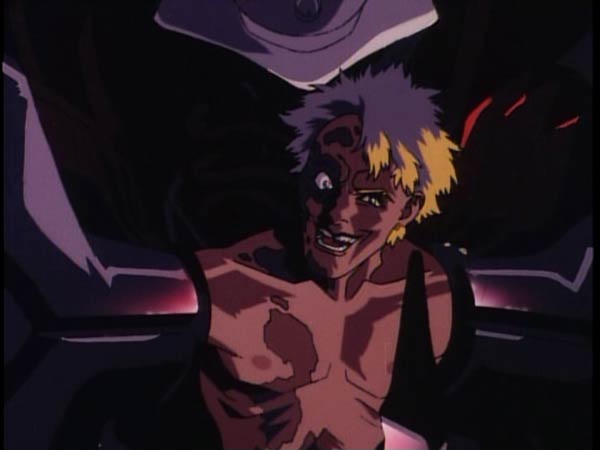
Armitage eventually broadens into a large-scale conflict that involves greedy corporations, inter-galactic disputes, android’s rights, population issues, and all the rest. We get LOTS of gun fights in this, and even a full scale battle, mecha style. In addition to being cute and vulnerable as an android wondering if she has a purpose in life, Armitage also kicks major ass in her burgundy leather ensemble. Guts, martial arts and all sorts of other gadgets come flying out of this chick. She is definitely, tough, strong willed, and lots of fun to watch.
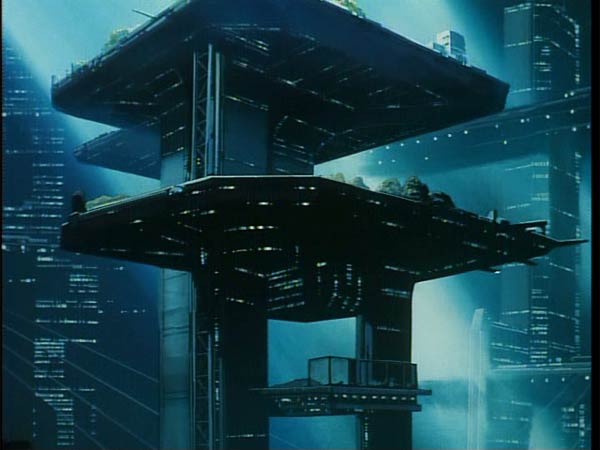
Notice the incredible similarity to another futuristic building in Metropolis.
The story is one of the most compelling in cyberpunk anime and really makes you feel for Armitage. Yes, the whole questioning of humanity by an android has been done before (and since) and since, but Armitage is definitely one of the better ones at this. Within the confines of a murder investigation, Armitage’s “soul” is exposed in her search for larger meaning and purpose, all while her fledgling relationship with a cyborg-hating policeman begins to emerge. Interesting questions are posed such as, what happens if an android has a fatal flaw? Should we throw them away is if they are they truly nothing more than a toaster? This is in essence a mirror to questioning how we deal with handicapped people in human society. We still consider handicapped people valuable and contributing members to society, but would we do the same with disabled Androids? At what point do they become real as opposed to simply remaining property - a tool for humanity?
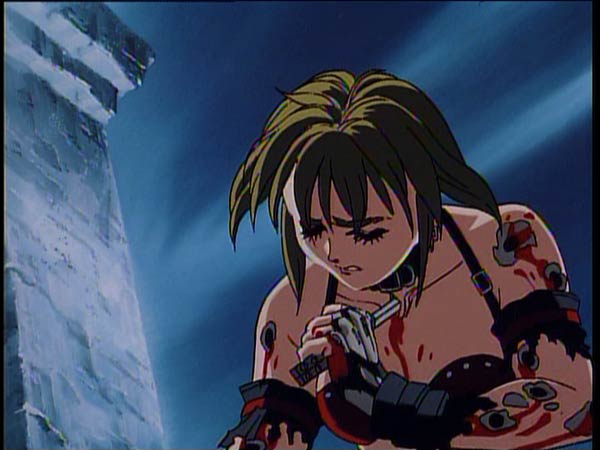
The Bottom Line: The visuals and sounds in Armitage III, while good, are somewhat dated and inconsistent. Some shots are absolutely superb, while others have a relatively plain background and almost 80s looking characters. Overall, there’s enough there to keep your interest, but its the story that delivers. Truly, I absolutely LOVE it!
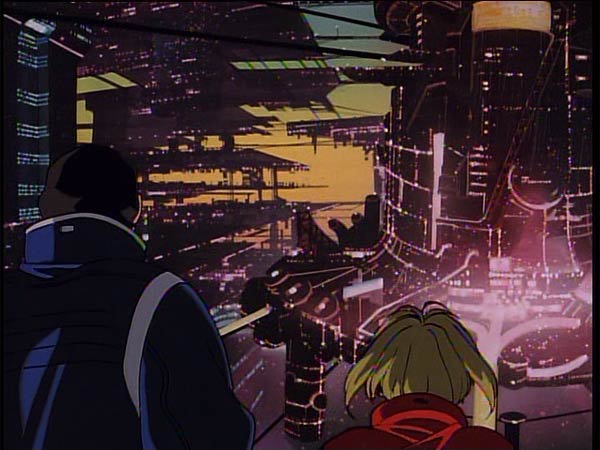
What is Armitage III Polymatrix? Polymatrix is a movie extracted from the 4 OAVs in Armitage III. While it is missing a few interesting scenes, its still watchable. It also has Kieffer Sutherland and Elizabeth Berkley as voice actors here, so if you can’t stand subtitles (You really fix this problem in the long run though), Polymatrix is a reasonable substitute. Some truly hate it primarily due to the English dubbing, the missing scenes and the changed ending. For me, I was OK with the dubbing, was generally OK with the scenes missing, but I liked the ending in the OAV (this movie) better.
~See movies similar to this one~
Year: 2003
Directed by: Jun-hwan Jeong
Written by: Jun-hwan Jeong
IMDB Reference
Degree of Cyberpunk Visuals: Very High
Correlation to Cyberpunk Themes: Medium
Key Cast Members:
Lee Byeong-gu: Ha-kyun Shin
Kang Man-shik: Yun-shik Baek
Su-ni: Jeong-min Hwang
Inspector Choo: Jae-yong Lee
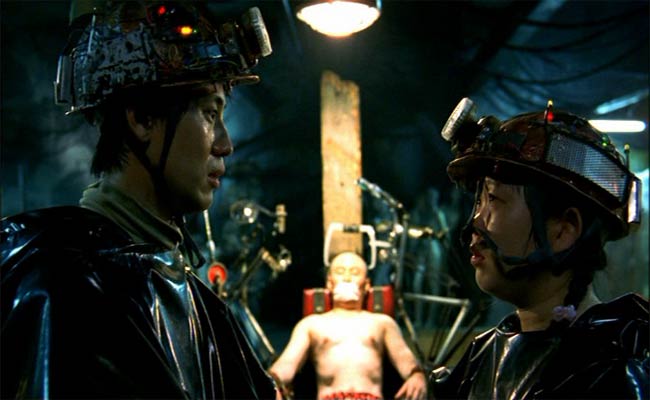
Overview: Here’s another movie that ranks really high on the weird shitometer scale - yet another cyberpunk movie from the tour-de-force of cyberpunk movies that Korea has become. Save the Green Planet is one of the only movies that has just about every movie genre represented. You’ll find everything from Gilliam-like comedy to graphic horror, to action, to scifi-thriller here. And of course, we get a large dose of Japanese-like Cyberpunk torture visuals in this terrific Korean production.
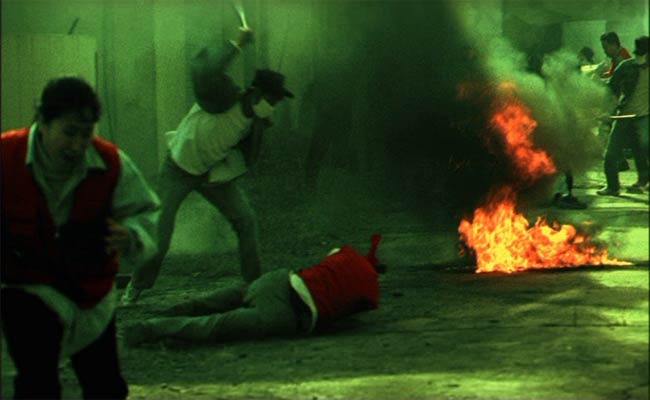
The Story: Save the Green Planet is about a completely strange guy and his even wierder ballerina girlfriend - our antihero is convinced that a certain CEO is really an alien in disguise. He has determined its his job to root the alien out and kill him if necessary, just like all the other “potential” aliens he has found in the past. After capturing him, He cuts the CEO’s hair off, as the aliens use hair follicles to communicate. He has other reasons for requiring foot torture and chest ironing. After all, good torture must always have a reason, right?
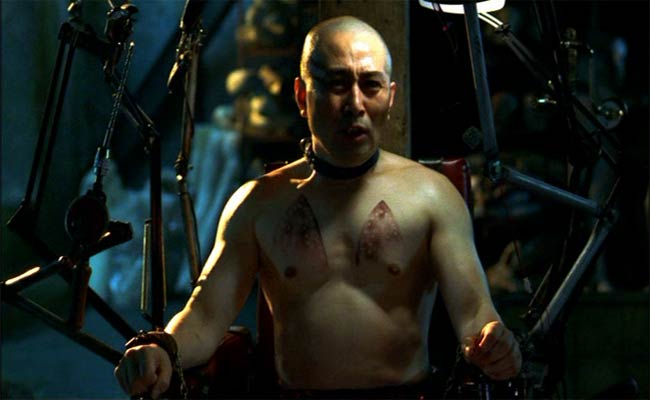
The Bottom Line: Its hard to go too much further into the plot for fear of giving key aspects of the movie away. Suffice to say the ending is terrific and fully open to interpretation, and actually has interesting similarities to the ending of Brazil. On top of this, Save the Green Planet is expertly shot, and wonderfully edited. The pacing is simply superb. It’s really hard to imagine that this is Jun-hwan Jeong’s first movie.
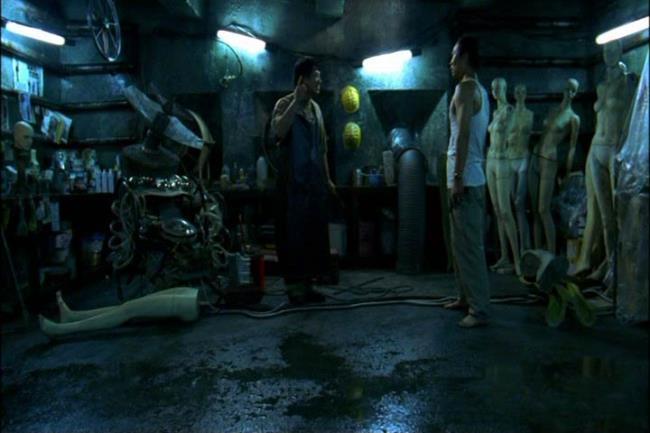
You gotta love the dolls everywhere. This guy makes them for his job.
Fair warning: Be warned though. This is a truly weird movie that his NOT for the squeemish at heart. While not a “true” Japanese cyberpunk movie in that, um, its Korean, and doesn’t totally take the “no boundaries” idea, it’s pretty darn close, and certainly merits mention in that sub-genre of cyberpunk. So much so that if you find real Japanese cyberpunk movies to be too much for you (And BTW, Tetsuo 2 doesn’t count, as this movie really doesn’t break ground and isn’t that good besides), Save the Green Planet is a decent entry to at least experience a similar pacing and mindset. Got to Page 2 for more screen caps.

Page 2: More Screen Caps–>>
~See movies similar to this one~
Tags: cyberpunk movie review Jigureul jikyeora
Year: 2001
Directed by: Mamoru Oshii
Written by: Kazunori Itô
IMDB Reference
Degree of Cyberpunk Visuals: Very High
Correlation to Cyberpunk Themes: Very High
Key Cast Members:
Ash: Malgorzata Foremniak
Murphy: Jerzy Gudejko
Game Master: Wladyslaw Kowalski
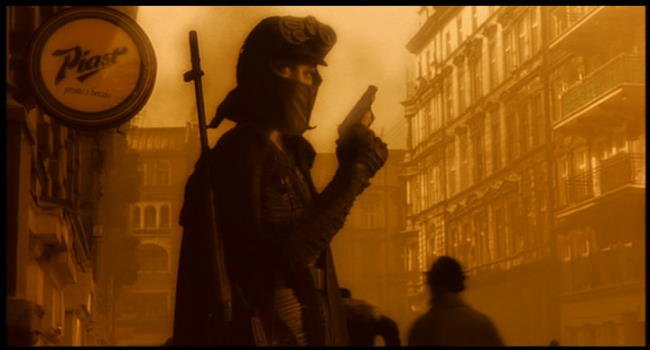
Overview: Mamoru Oshii, the master of philosophical cyberpunk animes ventures into a real world cinema production. The actors, dialogue and sets all take place in a Poland. Although this isn’t anime, the characters, cinematography and philosophy bare a striking resemblance to Oshii’s latest anime (which might show up on this list soon…). There is also many aspects of the Arthurian legend intermixed here, including the quest for the holy grail (understanding the nature of reality?), the search for the nine sisters of Avalon, and wizards, warriors and bishops. If you’re an Oshii fan, this is a must see. If you love VR game films this is a must see. If you like embedded philosophy and symbol laden movies, you will probably enjoy this. But if you’re coming purely for the action, there are probably better movies for you to spend your time on.
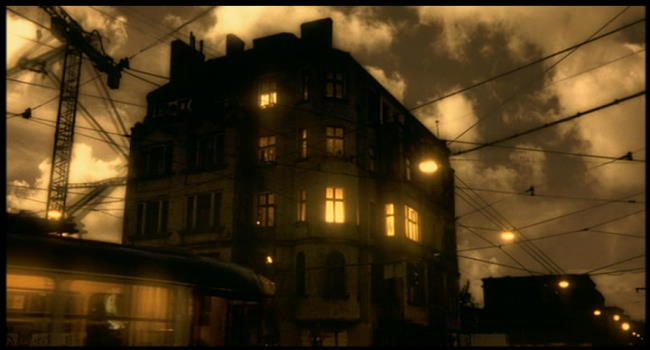
This movie takes place in a cyberpunk, dystopian future where the world is stark, devoid of real life or color, and where the only real enjoyment for young people exists in an illegal virtual reality game called Avalon. Avalon in mythical terms is the island where souls of the departed heroes come to rest. In the Virtual Reality Game of guns, tank and helicopter battles called “Avalon,” the players are the heroes, but there is a risk of actually becoming brain-dead while playing this game. In real life, the “unreturned” victims who never leave the game become human vegetables who sit around drooling in an insane asylum (this explains why the game is illegal).
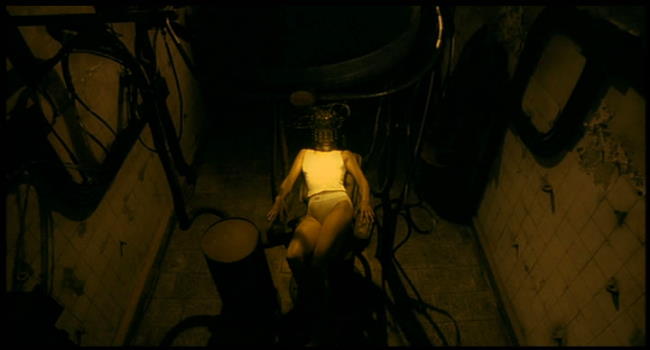
The main character is a hot warrior chick named Ash (wonderfully played by Malgorzata Foremniak). Once, she was a part of the best team in Avalon called Wizard. But something happened which caused one of the team members to panic under fire and call for a “reset” of the program (This is a traumatic action which causes all sorts of bad things to happen). This caused the team to disband and in Ash’s case, led her to be disconnected from all other players including Murphy, her team leader. Instead she becomes a supra-warrior who attempts to win the game going solo.
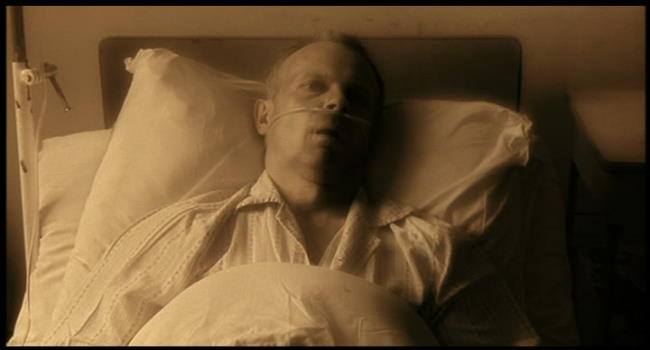
During her adventures, she learns that Murphy also went solo, and eventually worked himself up to finding a secret level called “Special A” that does not have a “reset” function. If you don’t complete the level, you don’t return. In essence, this level IS Avalon in the mythical sense. In Murphy’s case, he did not win, and ended up becoming one of the “unreturned” who lives out his “real” existence drooling in the asylum. Ash becomes obsessed with reaching this secret level so that she might find Murphy and return him. To complete this level, Ash needs to kill an illegal “unreturned” player. If she does wins, she will be offered a game admin job with Avalon. Unfortunately, Class Real is filled with “neutrals.” If Ash kills any neutral person she will lose, never to return.
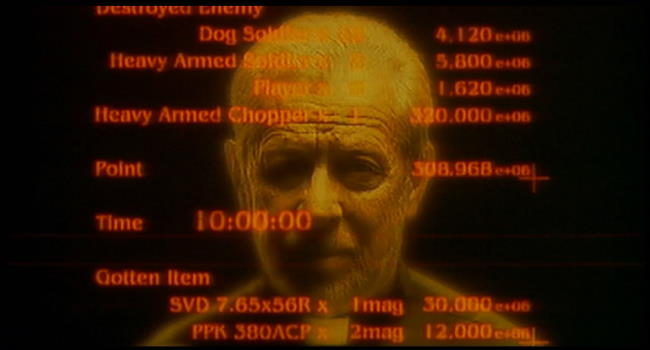
When Ash asks the Game Master if he’s real or not, his response is telling: “Does it matter if I’m real or not?” Like GITS:2 there is this notion that the line between what is real and what is imaginary almost doesn’t matter. What matters is what is actually occurring inside someone’s head: that is the “true” reality.
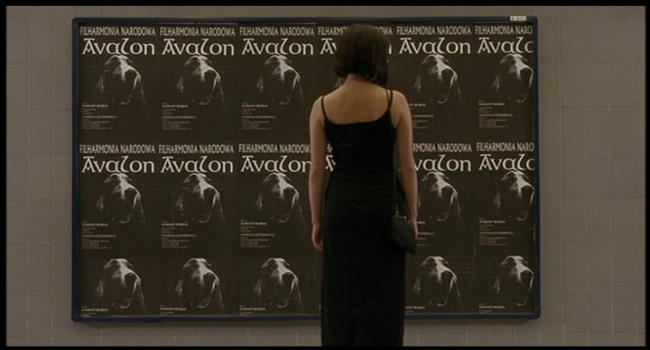
Use of a Dog as a metaphor for the “real” world: Again, similar to When Ash plays with her dog, she is participating in the “here and now.” Most of the time, Ash’s consciousness is situated in a timeless world where the actual real life moment is secondary to one’s perceptual reality. At one point early in the movie Ash wonders aloud, “Real life, is that what this is?” When she starts working at the computer, the dog goes to sleep, indicating that she has left real life and is in the game reality, if not in body, then definitely in spirit.
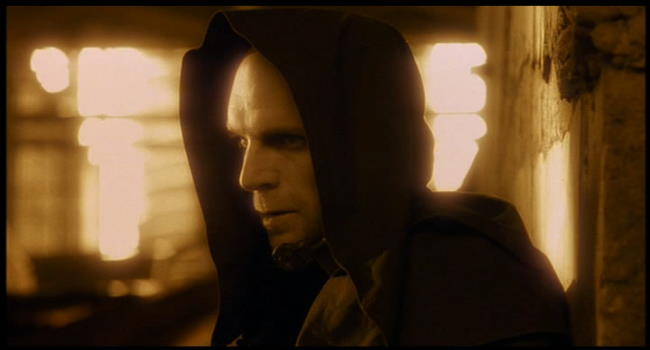
The cinematography: The cinematography in Avalon is strikingly familiar to Oshii’s latest anime. The same use of lighting, camera angles, and bright orange/yellow/brown tones are used. Interesting shots involving shadows abound. Throughout, the sets and camera pans are designed to elicit a closed-off, claustrophobic feeling. Everything, from Ash’s apartment to the train to the virtual reality headset rooms to the alleyways are bare and boxed in. Slow moving but sweeping pans add to the claustrophobia. Scenes are rarely at regular speed. Instead, the pacing is very slow moving to allow the audience time to take in the essence of the mood. In line with the pacing, Oshii continualy composes set shots similar to how he does in animes. In essence, we see glorious and elongated still shots of visually textured and wonderfully balanced objects.
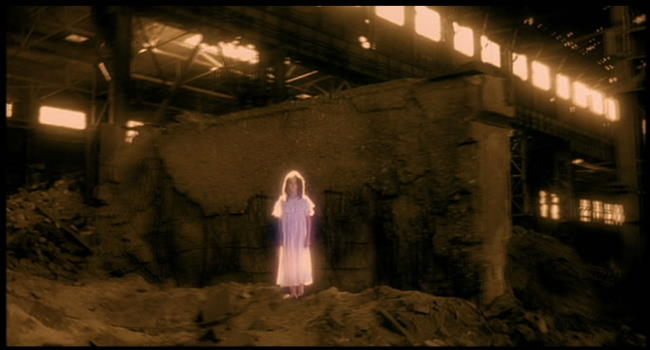
The FX and Sound: The special effects, while not on par with the high-end blockbusters, hold up well when compared to most VR type movies. Most impressive are the digitized explosions. When people and tanks "die" they digitally decompose in interesting ways. Similarly, when you enter the game, buildings auto-form. Also, the score is both haunting and moving. It highlights the slow build-up of thought and emotions. The mood of the film is clearly expressed through the score, which often serves as a catalyst for the pacing changes. As the major plot points change, so does the score radically follow suit. And the ending Avalon opera is just beautiful. I would pay to go see someone sing that.
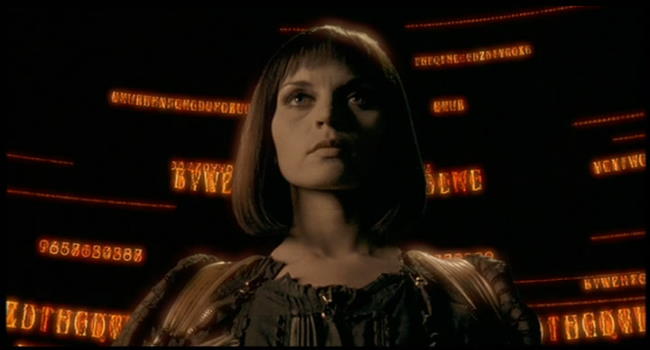
The Bottom Line: In short, Avalon is a wonderfully deep philosophical cyberpunk flick that fully explores whether reality truly matters. In essence, does it really matter if the fantasies we have running in our heads don’t really match the “reality” of the outside world? Or more to the point, is anyone really experiencing the reality of the outside world, or are we all just in our own personal Avalon? I hesitate to add more here, as doing so would spoil this most excellent movie for those few unfortunate souls who have yet to experience it. I have just one piece of advice - do so now!
But if you have seen it, I’d be happy do discuss detail philosophical thoughts with you concerning Avalon on Page 2: the Avalon Interpretive ending page. Many have expressed confusion over the ending, so I thought I’d share some thoughts on it. So if you have spoiler type questions about this movie, put them on page two (which also has more screencaps).
Page 2: Spoiler Discussion –>>
~See movies similar to this one~
Tags: cyberpunk movie review Avalon oshii
Year: 1998
Directed by: Ryutaro Nakamura
Written by: Chiaki Konaka
IMDB Reference
Degree of Cyberpunk Visuals: High
Correlation to Cyberpunk Themes: Very High
Key Cast Members:
Lain Iwakura: Kaori Shimizu
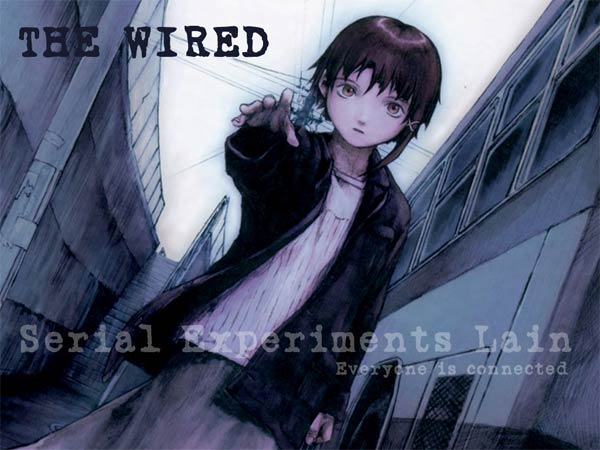
Overview: Serial Experiments Lain is a psychedelic, post-modern cyberpunk series that one wonders how the director ever managed to make. Lain centers on a very shy school girl who slowly begins to figure out that she is not what she seems to be. After getting a computer and connecting to the “wired,” something with is far more expansive than the internet, Lain begins to realize that she may not be human, and that truly, reality and the “self” is exists (or does not exist) on many different levels. As the story progresses, Lain “evolves” in terms of understanding what she is and her place in a very post-modern world. We also get many interesting side stories, including crime, teenage coming of age issues, and dastardly plots.
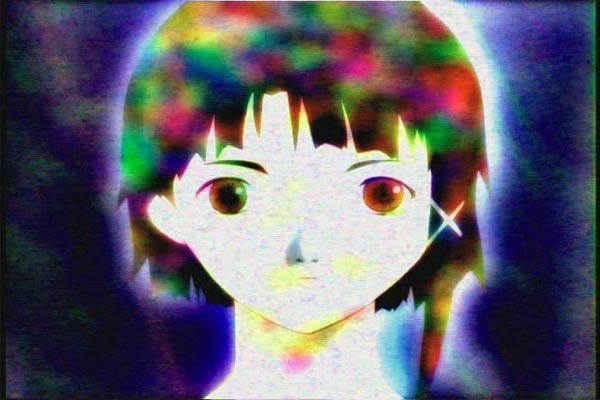
The pacing of Lain is just strange. Lain is NOT an action fest, nor is it by any means straight forward. Lain starts out rather slowly and gets weirder every episode. Truly, the story is told in a very “traditional” post-modern fashion in that we have fragmented vignettes structured in a seemingly random non-linear manner. Lain uses disconnected visuals to continually barrage the viewer with different textures, color schemes, and sounds. Yet over time, it becomes clear that the story is being spunk in seemingly a cyclical fashion, almost as if we are exploring a large Mandelbrot by starting at an outside spiral and slowly working our way around to the big picture. Each fragmented vignette gets added to until, at the end, we have a rather expansive tapestry to explore.
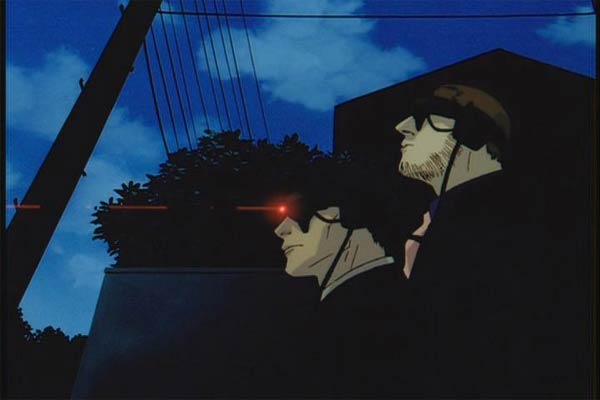
Many different and interesting philosophical ideas. But it is pure philosophical cyberpunk. Many key issues are discussed here, including:
- What constitutes “reality”?
- How real is time?
- What constitutes the “self” as a singular entity?
- What constitutes “God”?
- How are sentient programs different from humans?
- Is there such a thing as collective humanity?
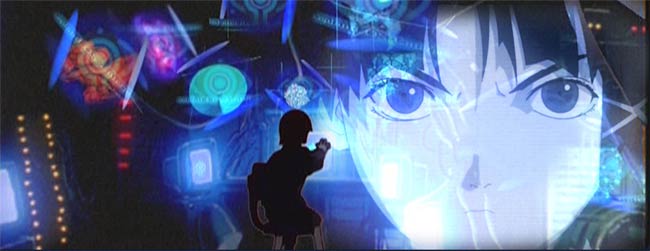
The visuals in Lain really aren’t there to “Wow” us as they are in some animes - instead they are often designed to provoke moods and thought patterns (BTW, there are so many screen caps available, that there was no need to take my own). Among the thought provoking visuals, we get:
- Psychedelic visions that explore multiple “selves” versus a singular “I”
- Juxtapositions of noise with false clarity
- Information Theory described visually
- An ever increasing feeling “disbelievability” each time the drab and normal school scene is shown.
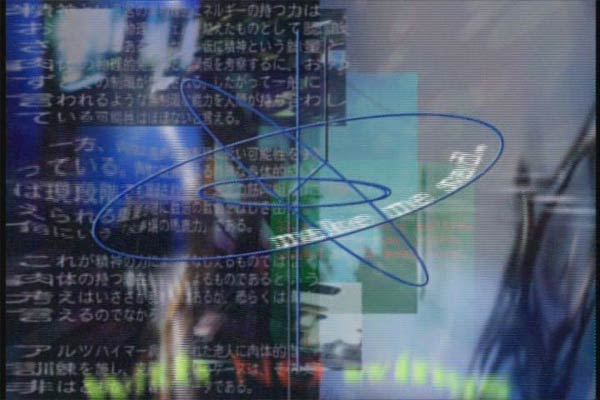
The Bottom Line: In the end, we are left with very open-ended thoughts. Serial Experiments Lain does not provide us with answers, instead, it opens us up to questions. And while I might argue that the post-modern pacing got too circular in places, and that I might argue the same tale could have been spun in half the time, the overall effect is rather extraordinary.
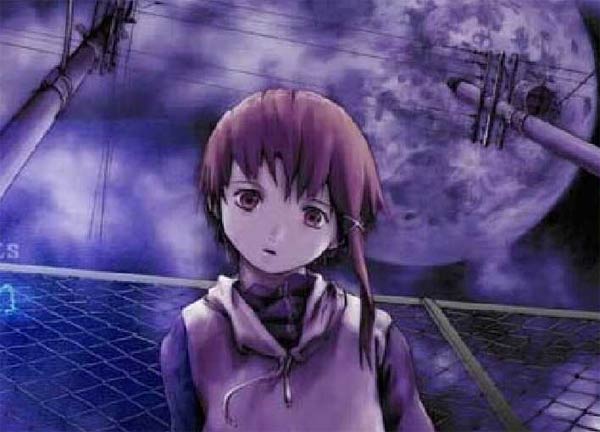
~See movies similar to this one~
Tags: cyberpunk movie review anime Serial Experiments Lain
Year: 2003
Directed by: Moon-saeng Kim, Park Sunmin
Written by: Moon-saeng Kim et al.
IMDB Reference
Degree of Cyberpunk Visuals: Very High
Correlation to Cyberpunk Themes: High
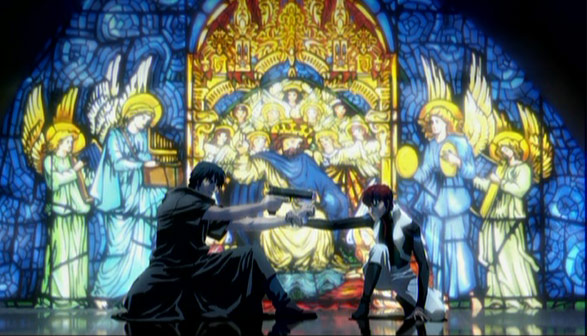
Overview: More often than not, most of the best scifi movies are coming from other countries. Anime is no exception. Wonderful Days (Called Sky Blue in some US locations) is a visual masterpiece of 2D/3D blended animation. While movies like Sinbad, with its wonderful background, but completely stuck on 2D characters shows us the low-end of this spectrum, Wonderful Days is a terrific example of the best in 2D/3D blended animation. This futuristic cyberpunk tale is not the most original, but is done more than well enough to allow to you be totally “wowed” by the visuals and incredible 3D positional sound.
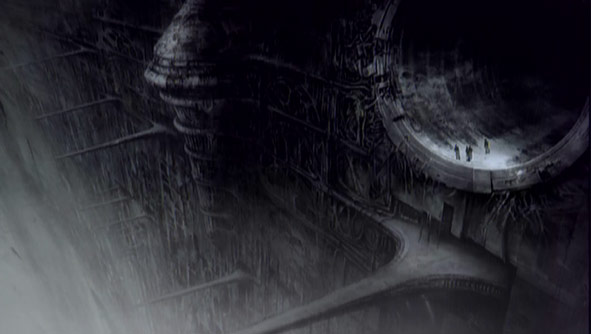
Wonderful Days takes place in a dystopic future in the year 2140. The world has been decimated and ravaged by war, reckless exploitation of the earth and over-pollution. Clouds have all but blocked out the sun and human civilization is on the brink of elimination. In this chaos, a group of elites have developed a method of using the pollution to create an energy source, and have used this to build a magnificent city called Ecoban.
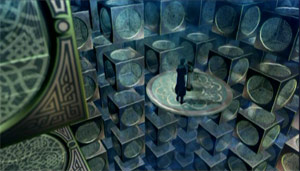 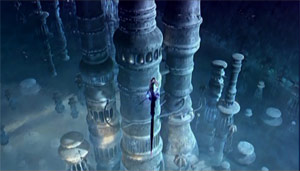
Thousands of Refugees have flocked to the Marr, the outskirt wasteland of this Ecoban in the hopes of gaining entrance, but unfortunately this has become a society of the elite and the masses. Instead, the citizens of Ecoban use the Marr as their personal slave labor to work the machines which keep Ecoban running. Life is cheap for the Marr, and the Ecoban elite care far more about their power generation than they do the welfare of the Marr. Unfortunately for the citizens of Ecoban, it appears as if the earth is starting to recover, and the level of pollution is dropping. The governing council has decided to use any means possible to maintain pollution levels to keep their hold on power.
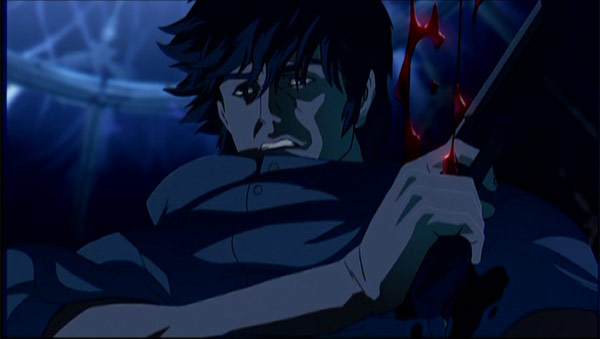
On a more personal level, this story revolves around three people, who knew each other as children living in Ecoban, but are now adults.
- Jay - a cute female captain of the Ecoban guard, who has begun to
doubt the system she supports.
- Shua - who was cast out of Ecoban as a child under dubious circumstances, only wants to show his adopted kid brother of the streets, Woody, what a blue sky looks like. He saw this once as a child with Jay, and has spent his life trying to overthrow Ecoban in order to see it again.
- Cade - the security commander of Ecoban, who is deeply in love
with Jay.
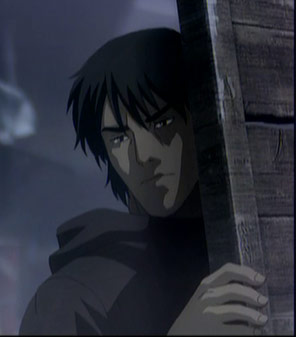 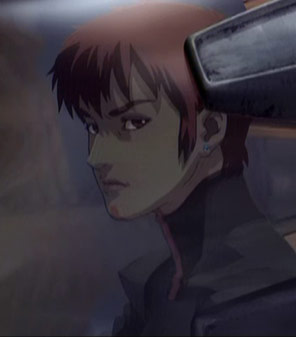
Shua, with the help of a aging Ecoban Engineer-turned resistance leader named Dr. Noah, who was involved in the creation of Ecoban’s power source, has infiltrated Ecoban’s key computer, the Delos System. There he hopes to get information to learn how to destabilize and destroy Ecoban. Unfortunately, he sets off alarms, and is forced to escape, and ends up facing off against his former best friend Jay. After he escapes, Jay seeks him out in the Marr, and they eventually re-establish their friendship, and eventually their love for one another. Meanwhile, Cade, with the help of the Malevolent Commander Locke will stop at nothing to protect the city he loves. When he finds out that his former rival Shua is involved, and that he is re-established contact with Jay, he only has one course to pursue - the total destruction of Shua and the resistance.
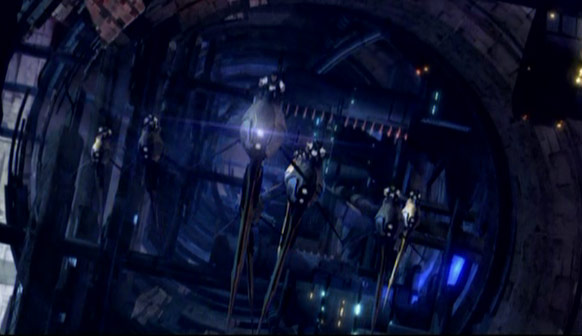
The Cinematography:While the story is by no means original, the cinematography is simply stunning on every level. Wonderful Days uses real film-like effects to increase the “realness,” believability and engagement far more than any animation I’ve seen. We get everything from the use of out of focus backgrounds, changing focal points, lens flares, jerky camera movements, and incredibly interesting perspective shots. On top of this, we get wonderfully rendered raindrops, rendered under-water explosions intermixed with hand drawn fire, and the most incredible array of deep and vibrant color effects in virtually every scene.
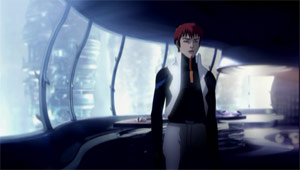 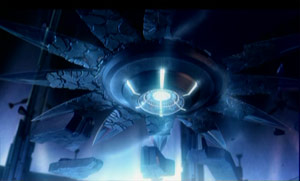
And while all this is astounding, what truly blows you away is the quality of the intermixing of 2D and 3D animation. Its almost hard to explain how well the 2D animation is blended, especially if you’ve seen something like Sinbad, which almost just layers the 2D on top of a background like velcro puppets on a background. Here we get blended effects that truly serve to tie the 2D with the 3D animation. Wonderful Days is simply the best out there at this type of animation.
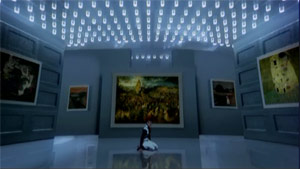 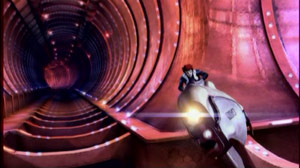
Sound Effects: While the cinematography is the real crown of this movie, the sound effects aren’t far behind. Truly, this is the best use of positional surround sound I’ve heard in an anime. We have wonderful “swoop” sounds by the motorcycles that are as good as live action racing movies, realistic explosions complete with pieces flying at you, detailed gunfire and wind sounds, and more importantly, a clear level of care throughout that rarely is equaled. As an interesting effect, the selections in the score are almost disconcerting in how different they are. We have everything from rock music to a wonderful use of opera at the end for emotional building.
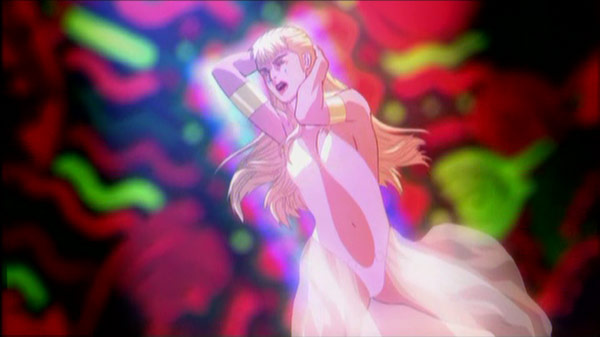
Is this Cyberpunk? You bet it is. While we don’t have the traditional merging of man and technology, all the other elements are here in spades. We get a glorious depiction of a the seedy underground, the powerful elite, impressive hacking, a wonderfully rendered dystopia, flawed heroes, and most importantly - style in abundant quantities!
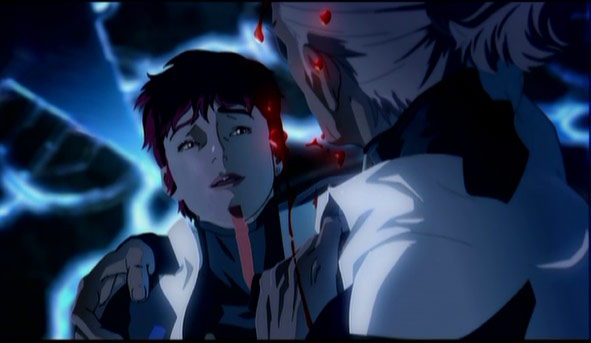 ] ]
The Bottom Line: If you’re interested in seeing the best in immersive scifi anime, Wonderful Days is a fine choice. While it doesn’t have close to the philosophical depth of Oshii’s movies, the story moves along and the immersive action is simply breathtaking. You truly do think you’re watching a continual piece of art go across the screen. And again, while the story is neither complex nor innovative, it is decently well done, especially if you dig cyberpunk-type themes. However, the quality of the cinematography and the intense care given to this film easily raises Wonderful Days up one of my favorite all-time cyberpunk movies.
Get this for the visuals and overall cyberpunk style. Wonderful Days truly deserves to be seen by all.
~See movies similar to this one~
Year: 2003
Directed by: Byung-chun Min
Written by: Byung-chun Min
IMDB Reference
Degree of Cyberpunk Visuals: Very High
Correlation to Cyberpunk Themes: Very High
Key Cast Members:
R: Ji-tae Yu
Ria: Rin Seo
Cyon: Jae-un Lee
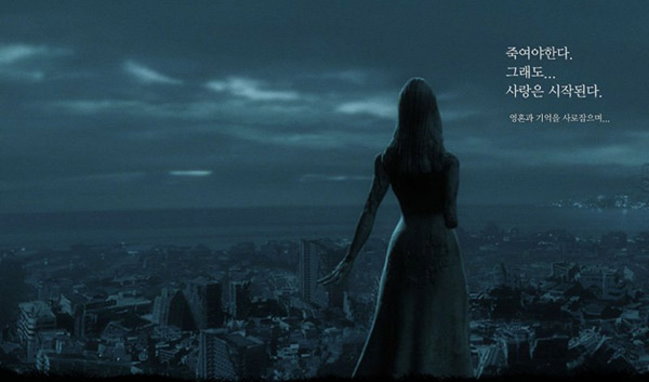
Overview: Natural City is a high priced attempt by the Korean movie industry to break into the Scifi Genre. The quality of the effects in Natural City clearly shine, both in the absolutely terrific set pieces, the painted backgrounds and the very realistic future setting. This is a cyberpunk movie to its core, with every possible aspect of cyberpunkness oozing from every pore of this movie. We get cyborgs, genetically engineered and cybernetically enhanced people, dominating corporations, theft and greed, seedy underground people and scenes, information access issues, and MASSIVE cyberpunk style. But truly, the reason Natural City rates this high is the absolutely wonderful cyborg character study in exploring issues of humanity.
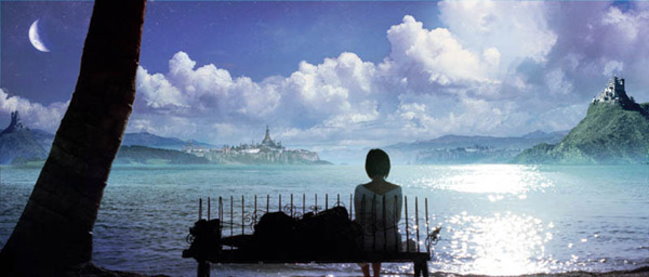
The Setting: Natural City as a title is 180 degrees from what you get in a setting - nothing is real here. In this dystopian setting, genetic engineering and cyborg development have become an accepted way of life. Pretty much everyone in this city lives a miserable existence, in fact, its expected that life is pain. Vacations are taken in the equivalent of a Star Trek Holodeck type machine. The ultimate dream of everyone in this city is to become rich enough to retire to a floating hotel called Muyoga (see the picture immediately below), which advertises that it can erase your current memory and place you in a "virtual" life of your own choosing. This is extremely interesting, especially when compared to Oshii’s Avalon, in which one view of the the "ultimate" life is one where you are in a simulated reality of your own mind even though your body is a slobbering mess in the "real" world.
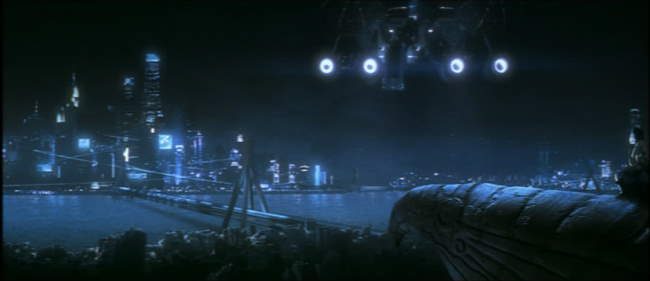
In Natural City, Cyborgs perform a myriad of societal functions - everything from entertainment and dancing, to restaurant helpers to working on the police force. To perform all these functions effectively, Cyborgs have a degree of self-awareness. This causes significant complications when their expiration date nears, as they know what it means to "expire." While some of the characteristics seem vaguely familiar to another far more famous cyberpunk movie (cyborgs with expiration dates, for instance), the story itself is radically different.
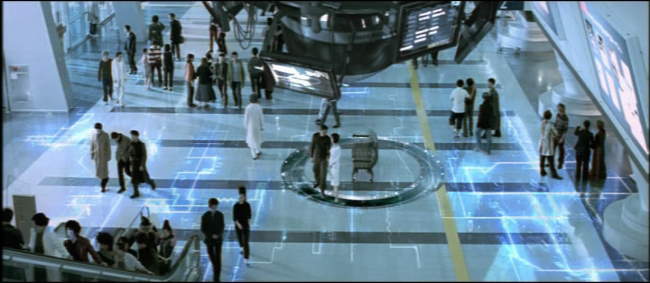
The Story: Natural City centers on the internal struggles of a highly talented cop named "R." He is tasked with finding and capturing renegade cyborgs, but ends up falling in love with a cyborg dancer named Ria who’s expiration date is only 3 days off. The movie centers on R’s compromising his principles and dealing with the cyborg underworld in a vain attempt to find a way to save his Ria. He finds a shady cyborg doctor who promises that if he finds a person with the right genetic match, he can inject part of their brain cells into Ria, which will save her. The doctor finds such a match in a street girl named Cyon.
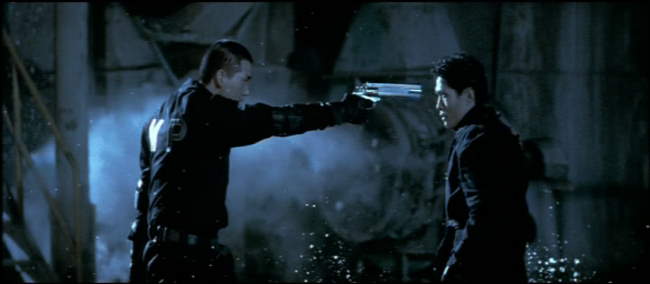
Complicating matters, R’s best friend Croy, who is also his boss and fellow police detective, has discovered his duplicity. During a raid to capture some renegade warrior cyborgs, Croy notices that R is not shooting them in the head (which kills them be wiping out their AI chip), but is instead going back later and collecting the AI chips to sell for money. Croy tracks R back to the shady doctor. Worse, one of the warrior cyborgs who escaped is also after Cyon for reasons that become all too apparent as the movie unwinds.
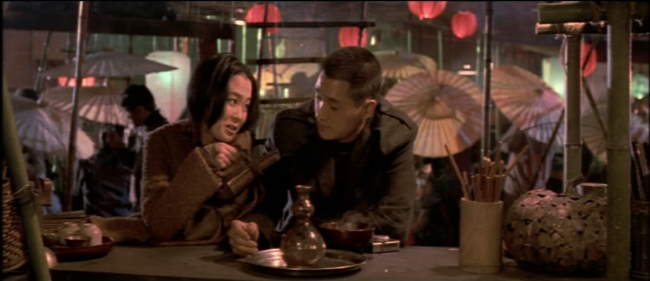
The Look: Natural City’s atmosphere is a grimy, lived-in futuristic environment. In some of the police scenes, Natural City comes across like a live-action Jin Roh movie (Jin Roh is definitely an influence for the action visuals). The high-quality and very original Scifi set pieces and occasional CG fits wonderfully, and along with the artistic backgrounds add up to a very immersive experience. The surround sound is not stunning, but is certainly decent and doesn’t detract from the experience. On top of this we get some wonderfully symbolic visuals, such as when Cyon sits atop a stone eagle statue, dreaming of life on the virtual hotel.
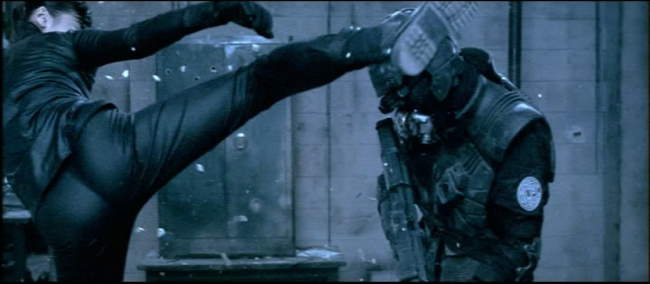
The Colors: Like most cyberpunk movies, Natural City uses one dominating color palette for the majority of the scenes. Blue is the color of choice, but varies from ultra-light to dark and dense blues. The lighter scenes usually depict high-tech human aspirations, whereas the darker scenes are left for massive action shots and for shots depicting the destruction of humanity, such as the gritty cyborg replacement lab. Every so often, we also get some really nice oranges and browns, but these colors are usually used more as chapter transitions.
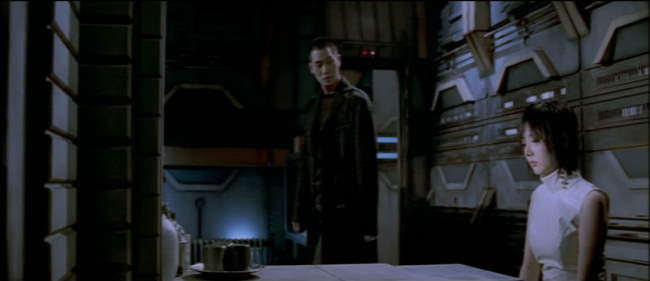
The Action: Natural City is a character exploration first, but the action and effects are on display, and in high quality. The action involves both slo-mo and high speed camera shots, along with LOTS and LOTS of blood and gore. The ending especially is somewhat of a gorefest, which is weird to see in a movie that is mostly a drama in nature. Also, near the end of the movie, we get treated to an evil, but ultra-hot cyborg warrior chick in skin tight lycra who engages in some major ass-kicking (see above for a pic of HER ass while kicking someone!). Talk about a plus! While we’re on the subject, we also get treated to some cute asian cyborg boobies at the beginning of Natural City - definitely a nice way to start the pic! (although, when you understand what the beginning boobie scene signifies it sorta takes away the fun).
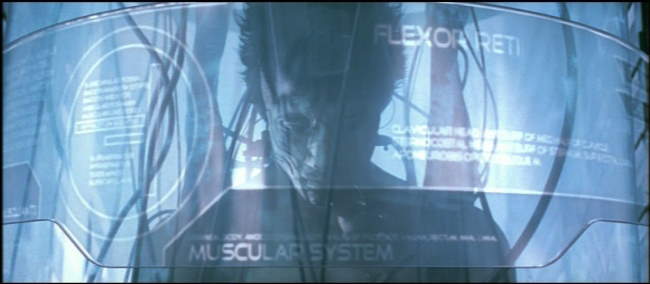
The Pacing: As I mentioned earlier, this IS a Korean movie. My wife is Korean, so I’m somewhat used to the pacing we see here. From reading a few reviews, Natural City has been panned for being way too slow and plodding in the middle. All I can say is, "Welcome to Korean Cinema." This is really a case where story telling is just different there. For a Korean, this movie is not at all slow, but has rather standard pacing, which means we get REAL in-depth and repeated scenes with the purpose of mood and detailed character study. Most important for Koreans is to be able to identify with the emotion and mood the characters are experiencing. Natural City takes the time to do this with all the main characters.
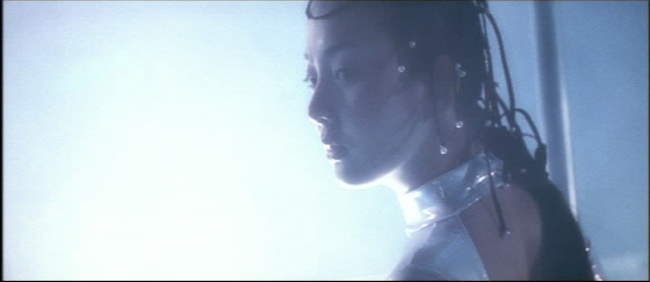
The characters really build in believability and engagement as the story progresses. At the beginning, R appears quite shallow, as does his friend and the street girl Cyon. By the end, all three, and especially Ria, his cyborg lover grow to be characters you really empathize with. The motivations for all become clear, including their virtues and flaws. The ending is also a rather "normal" Korean dramatic love story ending, which is to say, one very different from how an American film might end. Its not a feel-good movie, but then again, few Korean dramas are.
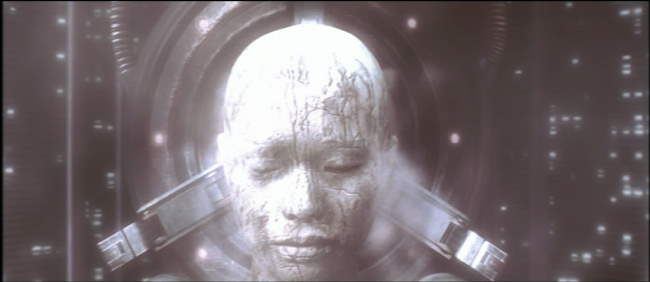
For me, the highlight of Natural City centered on Ria, the cyborg. To me, Ria captures the cyborg struggle for humanity better than any character in all cyberpunk movies save one scene (the Blade Runner’ sRoy Batty "I’ve seen things you wouldn’t believe" soliloquy, of course). While I didn’t catch this the first time through, the very beginning of the movie is told from Ria’s perspective, and then really, the last third of the movie centers on Ria (minus the action sub-plots). There are a few scenes that make it clear she "knows" what’s happening to her. She is programmed to be a dancer, but as she reaches her expiration date, she no longer can do this well. In one scene, Cyon shows her the "1 day" notice that arrives in the "Fifth Element" style mail slot. As her "time" approaches, you really do get the feeling of the Rutger Hauer speech at the end of Blade Runner, although Ria conveys this sentiment more broadly over a number of scenes and images. I want to go into this further, but this starts coming off as a spoiler, so I’ve added a more elaborative discussion of Ria’s motivations (spoilers) after the screencaps on Page 2.
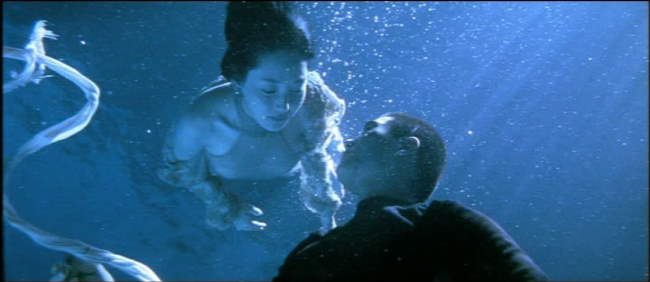
The Bottom Line: If you like cyberpunk films, the visuals alone make this a MUST SEE. If you like character studies in science fiction settings, you probably also want to see this. I truly LOVE Natural City, but be warned, the pacing is different from what you might expect. This is a Korean movie, and certainly plays like one. Also, be warned - like Wonderful Days, the ending has standard Korean Melodrama type stuff. While some might argue this doesn’t belong in the top 10, for me there’s no doubt that it does. The action and visuals are great, but Ria’s story clearly forces it there if nothing else.
Page 2: More Screen Caps and Ria’s Motivations Discussion (Spoiler)–>>
~See movies similar to this one~
Tags: cyberpunk movie review
Year: 1990
Directed by: Richard Stanley
Written by: Steve MacManus, Kevin O’Neill, Richard Stanley & Michael Fallon
IMDB Reference
Degree of Cyberpunk Visuals: High
Correlation to Cyberpunk Themes: High
Key Cast Members:
Jill: Stacey Travis
Moses Baxter: Dylan McDermott
Overview: Of all the movies I uncovered during my research for this list, Hardware far and above tops the list of movies I previously had no knowledge of. Put simply, Hardware is absolutely AWESOME low budget cinema. This cross between Alien and the Terminator is set in a totally weird cyberpunk dystopia. It’s scary as shit, it’s totally weird, and DAMN it’s good!
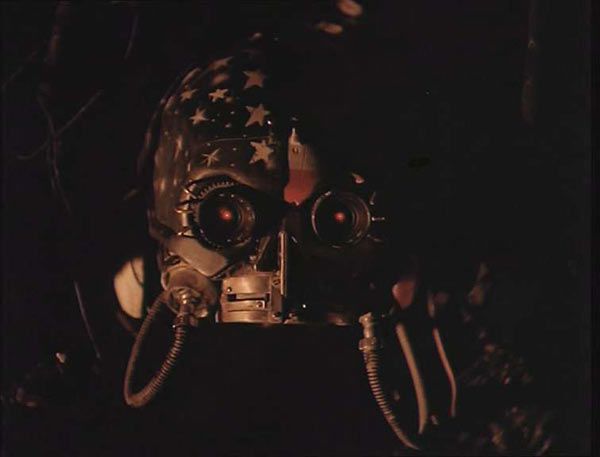
Filmed for only one million dollars, Hardware takes place in a truly bizarre dystopic future where a nomadic "parts" scavenger goes into a barren wasteland called the "zone" and finds a strange and seemingly valuable robot head and body parts. Through unfortuitous circumstances, this head finds its way back to a hot looking babe named Jill, an artsy-fartsy type (played wonderfully by Stacey Travis) who accepts it as a gift. She decorates the head with cool colors and stuff and sticks it on her shelf.

Unfortunately for her, it turns out this head and body parts make up the bulk of the government’s new prototype Mark-13 droid - a true killer designed to weed out excess population, that’s impervious to almost everything. Once this thing re-assembles itself, this thing begins its killing spree. On top of this, Hardware has some of the most eclectic collection of characters ever assembled. We have a totally slimy pervert that spends his time peeking in on Jill, especially when she’s in the nude; we have a completely shady parts dealer, we have a zen-like unknown nomad, we have a completely weird boyfriend’s sidekick, and some truly bizarre apartment tenants.
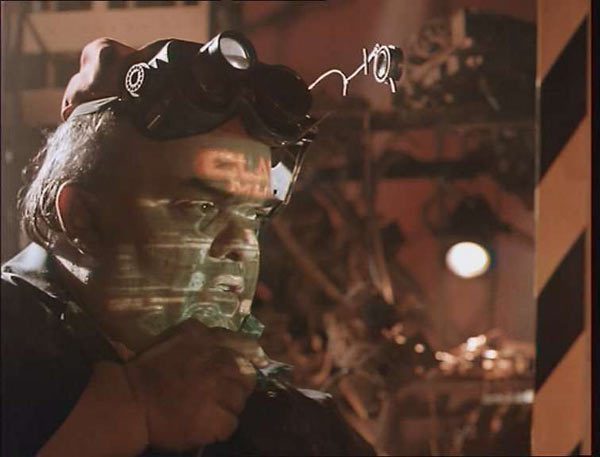
The Visuals: Like most cyberpunk films, there is one color that dominates the screen - in this case its orange. We get orange EVERYWHERE, along with a nice few accents of pale yellow. All the set pieces are totally futuristic and hip. We get fun advertisements on the radio, a totally hip atmosphere, and truly, one of the best soundtracks found in movies. Quite simply, Hardware ROCKS!
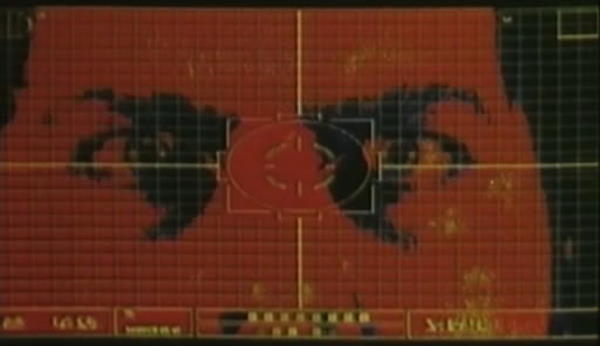
Now for the bad news - unless you’re in region 2, you’re screwed. I picked up a used VHS for about 17 bucks on ebay but still found it worth it. Unfortunately, this version is panned and scanned and cut. If I had obtained a "real" version of this movie, no doubt it would be sitting in my top 10.
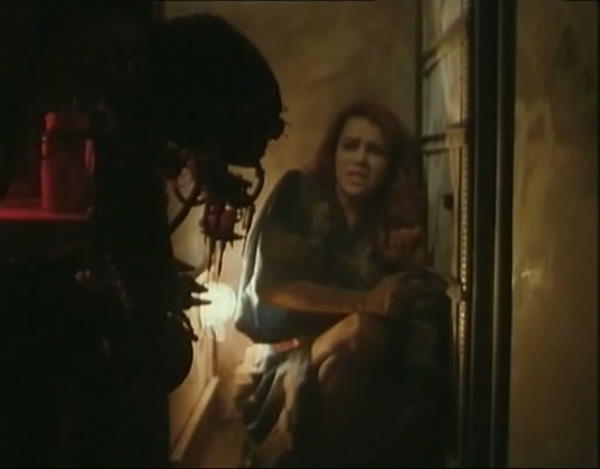
The Bottom Line: Hardware is a terrific, low-budget cyberpunk flick - one of the best low budget cyberpunk movies ever. If you are looking for a great, futuristic terminator-style chase movie that takes place almost completely in a bizarre apartment building, this is your movie!
~See movies similar to this one~
Tags: cyberpunk movie review Hardware
|









































 ]
]



















